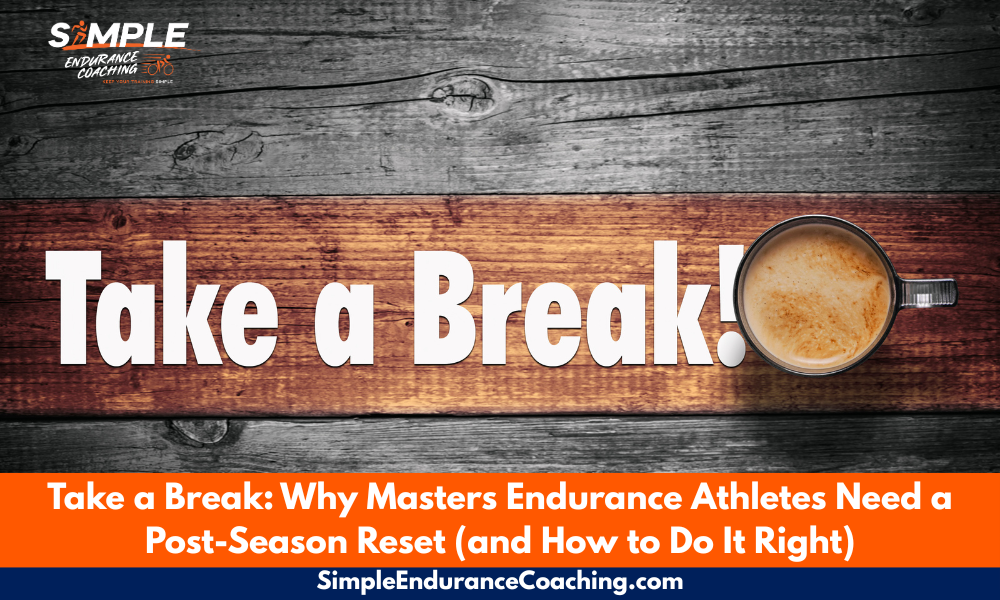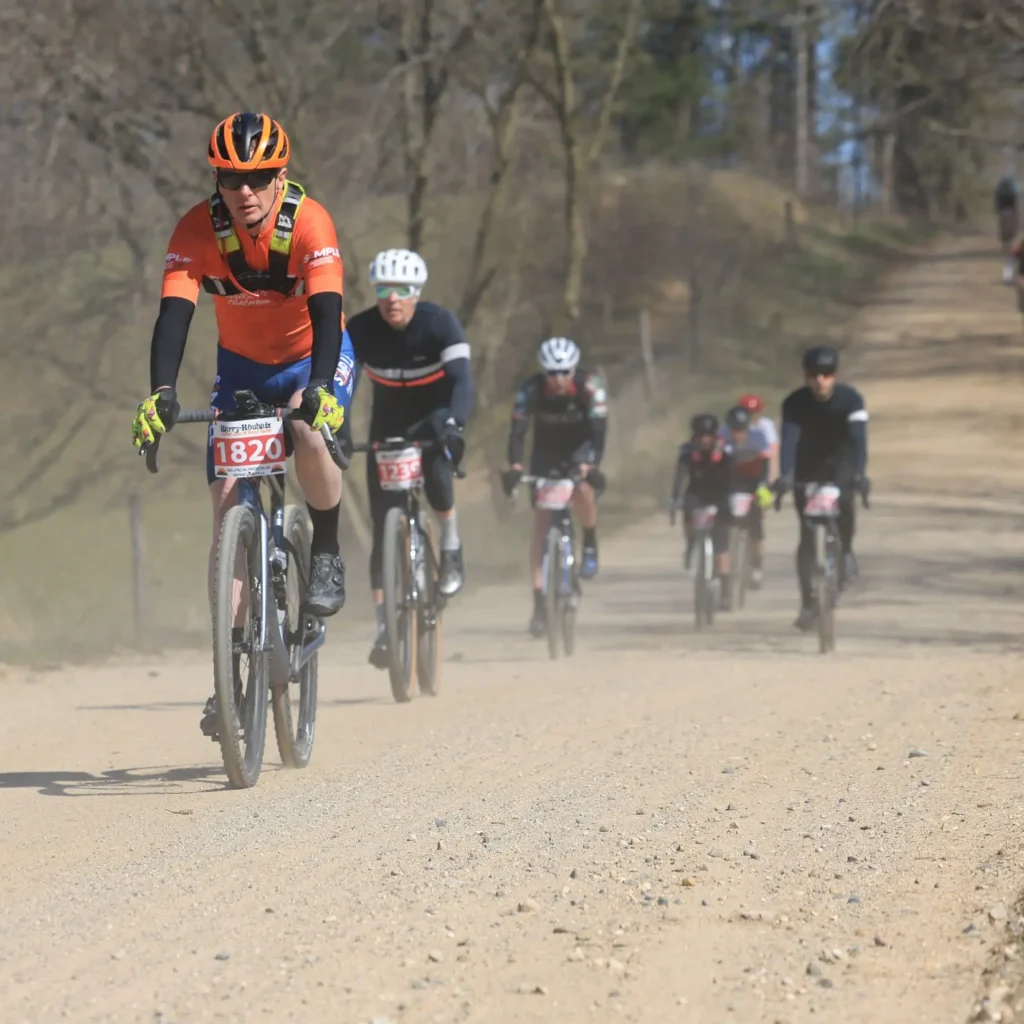Gravel Racing Training for Masters Cyclists: How to Train Smarter, Not Harder
Ready to take your gravel racing to the next level for the upcoming fall races?
As a master’s cyclist, you know that training smarter, not harder, is the key to success.
Gone are the days of endless punishing workouts and pushing yourself to the brink of exhaustion.
Instead, it’s time to fine-tune your approach and optimize your training for those long and challenging gravel races.
In this blog post, we’ll guide you through the best strategies for mastering gravel racing as a cyclist over 50.
We’ll talk about everything from training techniques tailored specifically for endurance events like gravel races to incorporating recovery, yoga, and strength training into your regimen.

How do I race smarter as a master’s cyclist?
Mastering the art of racing smarter as a master’s cyclist requires a strategic approach that goes beyond pure physical strength.
It’s about utilizing your experience and wisdom to make calculated decisions on the course.
First and foremost, it’s essential to know your strengths and weaknesses.
Assess your abilities honestly and focus on improving areas where you may be lacking.
By identifying what needs improvement, you can tailor your training specifically to address those aspects.
For example, you may not have explosive power to use at the start.
Ride within yourself and you’ll be catching people in no time.
Likewise, develop a race strategy that plays up your strengths while minimizing any weaknesses.
Study the course beforehand, understand its terrain and challenges, and plan accordingly, especially for nutrition and hydration.
This way, you can conserve energy when necessary or push harder in sections where you excel.
Gravel cycling endurance training is always about training smart.
What else should I do to race smarter?
In addition to physical preparation, mental fortitude is equally crucial in racing smarter.
Train yourself to stay focused even when fatigue sets in or unexpected obstacles arise during the race.
Visualization techniques can help build mental resilience by picturing yourself successfully navigating challenging sections of the course.
Strategic pacing is another key factor for mastering gravel races as a master’s cyclist.
Don’t get caught up in trying to keep up with faster riders early on; instead, find a rhythm that allows you to maintain a consistent speed throughout the entire race distance.
Remember also to fuel properly during longer races.
Develop an effective nutrition plan that provides adequate energy without causing digestive issues or energy crashes along the way.
Train smarter by practicing these nutrition plans during training, not the race!
By adopting these smart racing strategies – knowing yourself, developing a thoughtful race plan, building mental resilience, pacing wisely, and fueling effectively – you’ll optimize your performance as a master’s cyclist and increase your chances of crossing that finish line with pride!
What is the best way to train for long gravel races?
When it comes to training for long gravel races as a master’s cyclist, there are several key factors to consider.
The best way to approach your training is by incorporating a mix of endurance rides, interval sessions, and strength training.
First and foremost, prioritize building your endurance base.
This means logging miles on the bike consistently over time.
Start with shorter distances and gradually increase both the duration and intensity of your rides.
Aim for at least three longer rides per week, gradually increasing the distance each time, with at least one that is three hours or more.
These are slow endurance rides where you can have conversations and tell jokes.
In my endurance coaching, the two things I preach the most are doing long easy rides, and getting lots of recovery time.
Any bicycle training program for people over 50 needs to include plenty of recovery time. More on that later.
What else is important for training for long races?
In addition to endurance work, interval sessions are crucial for improving speed and power on the bike.
Incorporate high-intensity efforts into your training regimen such as hill repeats or intervals at race pace.
These intervals should be challenging but manageable in terms of effort level.
These will not only build your muscular endurance but help you learn to “suffer” when the race gets challenging.
Strength training is also important for masters’ cyclists.
Focus on exercises that target muscle groups used in cycling such as squats, lunges, deadlifts, and core exercises like planks or Russian twists.
Strength training can help improve overall power output and reduce the risk of injury.
Remember that every cyclist is unique; what works for one person may not work for another.
It’s important to experiment with different types of workouts and adjust accordingly based on how your body responds.
By following these principles – building endurance, incorporating intervals, including strength training exercises specific to cycling muscles – you’ll be well-prepared physically for those long gravel races ahead!
Keep pushing yourself but always remember to listen to your body along the way.
How much recovery will I need during training for long gravel races?
Recovery is a crucial part of any training program, especially when preparing for long gravel races as a masters’ cyclist.
It’s important to remember that the body needs time to repair and adapt after intense training sessions.
During your training, you may find that you need more recovery time than younger riders.
As we age, our bodies take longer to recover from strenuous exercise.
This means listening to your body and giving yourself adequate rest days between hard workouts.
I often recommend using HRV4Training to my athletes to monitor their fatigue.
One key aspect of recovery is sleep.
Aim for 7-9 hours of quality sleep each night to allow your body enough time to repair itself.
Sleep is when your muscles grow stronger and your energy levels replenish.
In addition to sleep, active recovery can also be beneficial.
Engaging in low-intensity activities such as walking or Recovery Yoga on rest days can help promote blood flow and aid in muscle recovery without placing additional stress on the body.
Fueling properly post-workout is another essential component of recovery.
Consuming a balanced meal or snack containing carbohydrates and protein within 30 minutes of completing your workout can help kickstart the healing process by providing the necessary nutrients for muscle repair.
Do I need strength training for Gravel Racing Training for Masters Cyclists?
As we mentioned earlier, strength training is an important component of any cyclist’s training program, regardless of age.
As a master’s cyclist, incorporating strength training into your routine can have numerous benefits.
It helps improve overall muscle strength and power, which translates to better performance on the bike.
By targeting specific muscles used in cycling, such as the quadriceps, glutes, and core muscles, you can enhance your pedaling efficiency and reduce fatigue during long gravel races.
Strength training also aids in injury prevention by strengthening the supporting muscles around joints.
When it comes to strength training for masters’ cyclists, focusing on compound exercises that work multiple muscle groups simultaneously is critical.
Deadlifts and lunges are excellent for building lower body strength while exercises like pushups and rows help strengthen the upper body.
It’s important to note that as a masters’ cyclist, recovery becomes even more crucial due to slower muscle repair processes.
Be sure to incorporate adequate rest days into your training plan to allow your muscles time to recover and adapt.
Should I do yoga for my gravel race training?
Yoga has gained a lot of popularity in recent years, and for good reason.
It offers numerous benefits for both breathing and mobility.
Yoga can be incredibly beneficial for gravel race training.
Not only does it improve mobility, but it also helps build strength and balance – two key components of successful cycling.
The flowing movements and poses in yoga help to lengthen muscles that tend to get tight from hours spent on the bike.
Additionally, practicing yoga can enhance your mental focus and concentration – crucial elements when tackling long gravel races.
The breathing techniques taught in yoga classes can help you stay calm under pressure and manage discomfort during intense rides.
How do I know training is working as gravel racing training for masters cyclists?
As a master’s cyclist, it is important to have a clear understanding of how your gravel training is progressing.
Here are some ways to evaluate the effectiveness of your training:
- Time and Distance: Keep track of your training rides and races by recording the time taken and the distance covered. Gradually increase both parameters over time to gauge improvement.
- Power Output: Utilize power meters or heart rate monitors to measure your output during training sessions. By tracking your power numbers, you can determine if you are getting stronger and more efficient on the bike.
- Rate of Perceived Exertion (RPE): Pay attention to how hard each workout feels using a scale from 1-10, with 10 being extremely difficult. If you find that you’re able to maintain higher speeds or complete longer distances at lower perceived exertion levels, it indicates progress in your fitness level.
- Recovery Time: Notice how quickly you recover after intense workouts or long rides. As you become fitter, recovery times should shorten, allowing for more consistent training without excessive fatigue.
- Race Results: One of the best indicators of progress is race performance. Compare your results in gravel races over time and see if there is an upward trend in terms of finishing times or overall ranking within your age group.
- Efficiency Factor – if you use Today’s Plan or Training Peaks, you’ll be able to see your efficiency factor – a measure of your heart rate compared to power – increase.
Remember that progress may not always be linear; there will be ups and downs along the way due to factors such as weather conditions, external stressors, or even just an off day on the bike.
Be patient with yourself but stay committed to consistent training and listen to what your body tells you.
Here are three things to remember about gravel racing training for master’s cyclists:
- Do long endurance rides where you practice hydration and nutrition
- Do hard intervals where you build muscle endurance and practice the kinds of challenges you’ll have on the course.
- Recovery fully with yoga, rest days, and good nutrition.
Need more?
Get a free Core Strength and Stability training video when you opt-in to receive my weekly blog posts about what works in endurance sports.
Sign up for Virtual Coffee so we can discuss your goals, ask questions, and talk about making your endurance training more effective, fun, and Simple.
Paul Warloski is a:
- USA Cycling Level 3 Coach
- RRCA Running Coach
- Training Peaks Level 2 Coach
- RYT-200 Yoga Instructor
- Certified Personal Trainer




